
Livebearers are aquarium fish that retain the eggs inside the body and give birth to live, free-swimming young. Among aquarium fish, livebearers are nearly all members of the family Poeciliidae and include guppies, mollies, platies and swordtails.

The southern platyfish, common platy, or moonfish is a species of freshwater fish in family Poeciliidae of order Cyprinodontiformes. A live-bearer, it is closely related to the green swordtail and can interbreed with it. It is native to an area of North and Central America stretching from Veracruz, Mexico, to northern Belize.
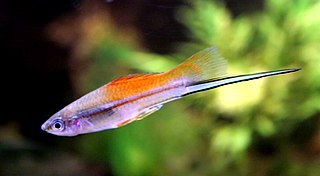
Xiphophorus is a genus of euryhaline and freshwater fishes in the family Poeciliidae of order Cyprinodontiformes, native to Mexico and northern Central America. The many Xiphophorus species are all known as platyfish and swordtails. Platyfish formerly were classified in another genus, Platypoecilia, which is now obsolete. The type species is X. hellerii, the green swordtail. Like most other new world Poeciliids, platies and swordtails are live-bearers that use internal fertilization and give birth to live young instead of laying eggs like the bulk of the world's fishes. The name Xiphophorus derives from the Greek words ξίφος (dagger) and φόρος (bearer), referring to the gonopodium on the males. All are relatively small fishes, which reach a maximum length of 3.5–16 cm (1.4–6.3 in) depending on the exact species involved.

Poecilia is a genus of fishes in the family Poeciliidae of the order Cyprinodontiformes. These livebearers are native to fresh, brackish and salt water in the Americas, and some species in the genus are euryhaline. A few have adapted to living in waters that contain high levels of toxic hydrogen sulfide and a population of P. mexicana lives in caves.

The Monterrey platyfish is a species of freshwater fish in family Poecilidae. A live-bearer, it was native to a very small section of the San Juan River system in the vicinity of the city of Monterrey, Mexico. The specific name refers to the American soldier and naturalist Darius N. Couch (1822-1897) who collected the type on a self financed expedition to Mexico.

Poecilia wingei, known to aquarists as Endlers or Endler's livebearer, in the genus Poecilia, is a small fish native to the Paria Peninsula in Venezuela. They are prolific breeders and often hybridize with guppies. These very colorful hybrids are the easiest to find being offered in pet-shops, typically under the name Endler's guppy.
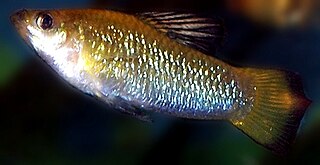
Limia is a genus of livebearing fishes belonging to the Cyprinodontiform family Poeciliidae, which includes other livebearers such as platys, swordtails, guppies and mollies. They are found in fresh and brackish water. Of the 21 described Limia species, 17 are endemic to Hispaniola, one is found on both Hispaniola and Jamaica, and the Cayman Islands, Cuba, and Venezuela have an endemic species each. Limia are popular in aquaria among more advanced hobbyists.
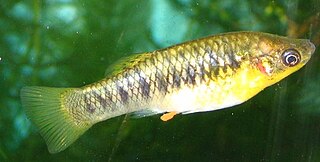
The humpbacked limia or black-barred limia is a species of poeciliid endemic indigenous to Haiti. This species grows to a length of 5.2 centimetres (2.0 in) SL. Its natural habitat is in streams and lagoons, where it is associated with the cover of aquatic plants. It is also found in the aquarium trade. Males actively court and pursue females, they threaten each other, but if the males are evenly matched no damage generally results. Often, the dominant male will harass smaller males until they expire, so often, that only one male will survive in a colony. They are closely related to the "Tiger" limia.

Heterandria formosa is a species of livebearing fish within the family Poeciliidae. This is the same family that includes familiar aquarium fishes such as guppies and mollies. Heterandria formosa is not as commonly kept in aquaria as these species. Despite the common name "least killifish", it belongs to the family Poeciliidae and not to one of the killifish families. H. formosa is one of the smallest fish species; the 1991 Baensch Aquarium Atlas listed it as the 7th smallest fish in the world, and as of 2006 it remains the smallest fish species found in North America.
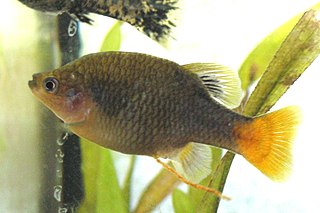
The redtail splitfin or redtail goodeid is a species of goodeid fish from the family Goodeidae and subfamily Goodeinae. Like other members of Goodeinae, the redtail splitfin is native to Mexico and a livebearer. However, the goodeid mating system differs in several ways from the more common livebearing fish from the family Poeciliidae that includes guppies and swordtails. While no goodeid species is a very popular aquarium fish, the redtail splitfin is one of the most popular. Only the male has the red-orange tail for which it is named. Its specific name honours the collector of the type, Gustav Eisen (1847–1940) who was Curator of Marine Invertebrates at the California Academy of Sciences in San Francisco, California.

The guppy, also known as millionfish and rainbow fish, is one of the world's most widely distributed tropical fish and one of the most popular freshwater aquarium fish species. It is a member of the family Poeciliidae and, like almost all American members of the family, is live-bearing. Guppies originate from northeast South America, but have been introduced to many environments and are now found all over the world. They are highly adaptable and thrive in many different environmental and ecological conditions. Male guppies, which are smaller than females, have ornamental caudal and dorsal fins. Wild guppies generally feed on a variety of food sources, including benthic algae and aquatic insect larvae. Guppies are used as a model organism in the fields of ecology, evolution, and behavioural studies.

The green swordtail is a species of freshwater/brackish fish in family Poeciliidae of order Cyprinodontiformes. A live-bearer, it is closely related to the southern platyfish or 'platy' and can crossbreed with it. It is native to an area of North and Central America stretching from Veracruz, Mexico, to northwestern Honduras.

Platy is a common name of freshwater fish in the genus Xiphophorus that lacks a "sword" at the bottom of their tails. Both species are livebearers, similar to other fish of the family Poeciliidae, such as the guppy and molly. Platies are native to the east coast of Central America and southern Mexico.

The pike topminnow, more commonly known as pike killifish and sometimes referred to as topminnow, is a species of poeciliid found from Mexico to Nicaragua. It has also been introduced to Florida, USA. It is the only known member of its genus. The pike topminnow was described in 1860 by Austrian ichthyologist Rudolf Kner, who gave the type locality as Belize, which is reflected in this species' specific name.
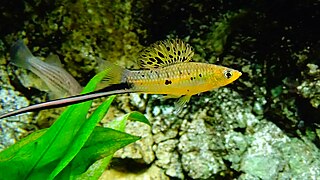
Xiphophorus montezumae, the Montezuma swordtail, is a livebearing freshwater fish of the order Cyprinodontiformes, family Poeciliidae, and genus Xiphophorus. It is in the same genus as the common platy and the swordtail. Xiphophorus means 'sword-tail' in Greek.
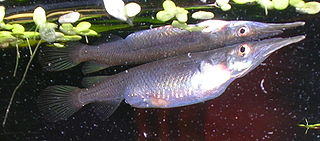
Zenarchopteridae, the viviparous halfbeaks, is a family in the order Beloniformes. The Zenarchopteridae exhibit strong sexual dimorphism, practicing internal fertilisation, and in some cases ovoviviparous or viviparous. The members in the family are mainly found in fresh and brackish water of tropical Asia and New Guinea, but the genus Zenarchopterus also includes marine species from the Indo-Pacific. Several, such as the wrestling halfbeak, have become commonly traded aquarium fish.

Pregnancy has been traditionally defined as the period of time eggs are incubated in the body after egg-sperm union. Although the term often refers to placental mammals, it has also been used in the titles of many international, peer-reviewed, scientific articles on fish, e.g. Consistent with this definition, there are several modes of reproduction in fish, providing different amounts of parental care. In ovoviviparity, there is internal fertilization and the young are born live but there is no placental connection or significant trophic (feeding) interaction; the mother's body maintains gas exchange but the unborn young are nourished by egg yolk. There are two types of viviparity in fish. In histotrophic viviparity, the zygotes develop in the female's oviducts, but she provides no direct nutrition; the embryos survive by eating her eggs or their unborn siblings. In hemotrophic viviparity, the zygotes are retained within the female and are provided with nutrients by her, often through some form of placenta.

Poeciliinae is a subfamily of killifish from the family Poeciliidae which contains species from the Americas which are collectively known as the livebearers because many, but not all, of the species within the subfamily are ovoviviparous.

Alfaro cultratus, the knife livebearer, is a species of tropical freshwater fish from the family Poeciliidae. It hails from Central America and is often kept in home aquaria.

Limia islai, also known as the tiger limia, is a species of fish within the family Poeciliidae. This species is one of several Limia, which are endemic to Lake Miragoâne, Haiti.





















